13.4 Workstation Import Policy
The Workstation Import policy sets parameters to control automatic workstation importing. It must be enabled for Automatic Workstation Import to function. For more detailed information, see Section 7.1, Understanding Workstation Import and Registration.
You can set rules on how Workstation objects are named and where they are created. You should decide if you want to create Workstation objects in their own containers or in the container where the User objects reside.
You might find it easiest to manage Workstation objects in a common container if your User objects are scattered among various containers in the tree.
You might also find it easiest to keep User and Workstation objects in the same container.
While performing the following steps, you can get detailed information about each dialog box by clicking the button.
To set up the Workstation Import policy:
-
In ConsoleOne, right-click the Server Package, click , then click the appropriate platform page.
Policies set on a specific platform override policies set on the tab.
-
Select the check box under the column for the Workstation Import policy.
This both selects and enables the policy.
-
Click to display the Containers page.
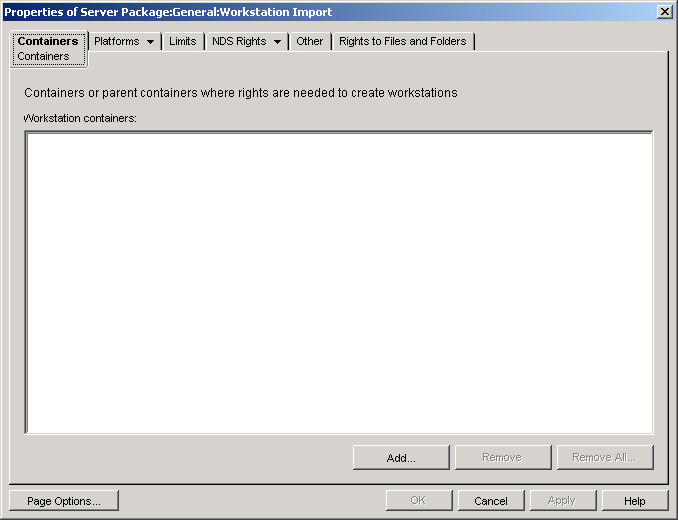
-
Click , select the eDirectory™ containers where rights are needed for creating Workstation objects, then click .
-
Click the tab.
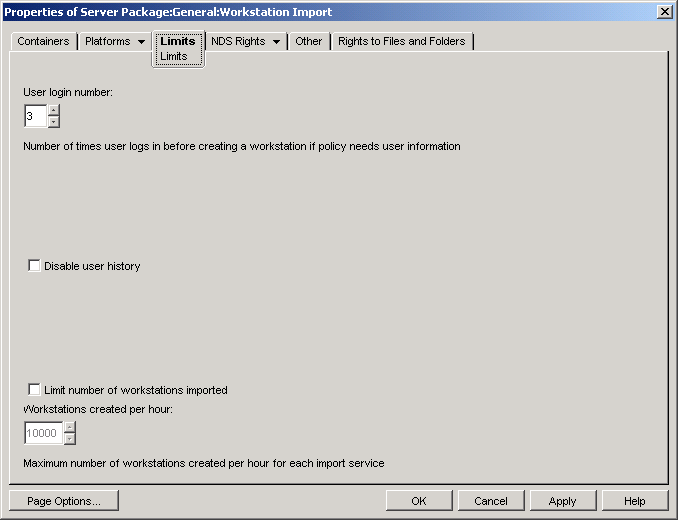
-
Fill in the fields:
User Login Number: If the Workstation Import policy requires user information, this number represents the number of times the user needs to log in before the user’s Workstation object is created.
Disable User History: Each time a user logs in to a workstation, the Workstation object's User History page is updated so that an administrator can view a complete list of all users who have logged in to that workstation. If you do not want user history to be collected for workstations, you should enable this option.
This option lets you disable the collection of user history for all workstations imported after you enable this option. To disable user history collection on workstations that were imported before you enabled this option, right-click the appropriate Workstation object, click , click the tab, then select the check box.
Limit Number of Workstations Imported: To help balance server workload, enable this option to limit how many workstations are imported. When you select this option, the box is available.
Workstations Created Per Hour: Specify the limit for how many Workstation objects can be created per hour.
-
Click the tab, then click , , , , or , as applicable.
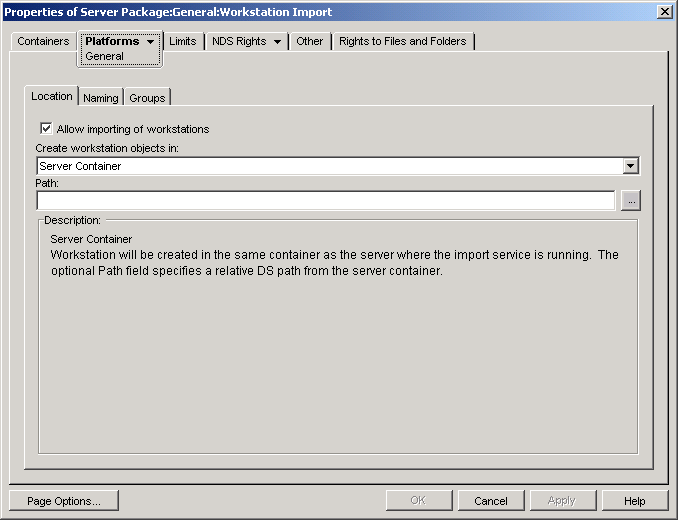
-
Fill in the fields:
Enable Platform Settings to Override General Settings: This check box appears only on the WinNT, Win2000, WinXP, and Win9x platform pages; it does not appear on the General page. Select this check box to override the settings on the General page with the setting you configure on one of the four specific platform pages.
Allow Importing of Workstations: Enable this option to allow registered workstations to be imported.
Create Workstation Objects In: Select an option from the drop-down list:
-
Selected Container: The Workstation object is created in the container specified in the Path field. This is an absolute path.
-
Server Container: The Workstation object is created in the same container as the server running the import service. You can specify a relative path from the server container.
-
User Container: The Workstation object is created in the container where the User object resides for the logged-in user. You can specify a relative path from the user container.
-
Associated Object Container: The Workstation object is created in the container that is associated with the Workstation Import policy. You can specify a relative path from the associated container.
Path: If you are using a relative path, specify a string. The number of periods you end the path with determines the number of relative levels. If you are using an absolute path, select the container.
-
-
Click the tab.
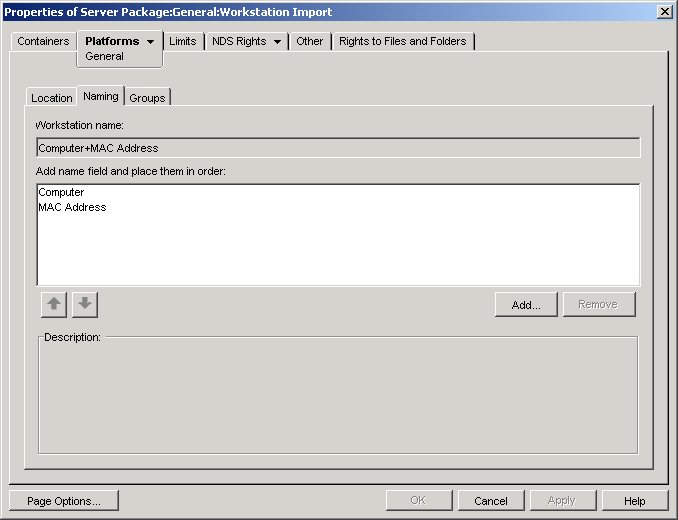
-
Fill in the fields:
Workstation Name: Displays the workstation naming convention currently defined in the list. Whenever there is a potential name conflict (such as two Workstation objects in the same container named after the User object), the system appends a 3-digit number on the end of the name that you enter here.
Add Name Fields and Place Them in Order: You must have at least one option in this list. By default, is displayed in the list. Click to select from the following list of name fields. After creation of the Workstation object, this information is static and does not change.
Name Field
Description
Computer
The Windows computer name, usually as it was named during the Windows installation process.
MAC Address
The workstation's MAC address. This address is unique to the workstation's network card.
Container
The container where the User object resides.
<User Defined>
You can type your own information here. You must use characters that are valid in a DS object name. Do not use the following characters:
-
Underscore ( _ )
-
Asterisk (*)
-
Less than symbol (<)
-
Greater than symbol (>)
-
Semicolon (;)
-
Pound sign (#)
User
The name of the user that is logged in.
IP Address
The workstation's Internet Protocol (IP) address.
DNS
The Domain Name System name (the logical name related to the IP address).
Server
The workstation's preferred server.
OS
The workstation's operating system (Windows 98, Windows NT, Windows 2000, Windows XP).
CPU
The type of central processing unit in the workstation (386, 486, Pentium*, and so forth).
-
-
Click the tab.
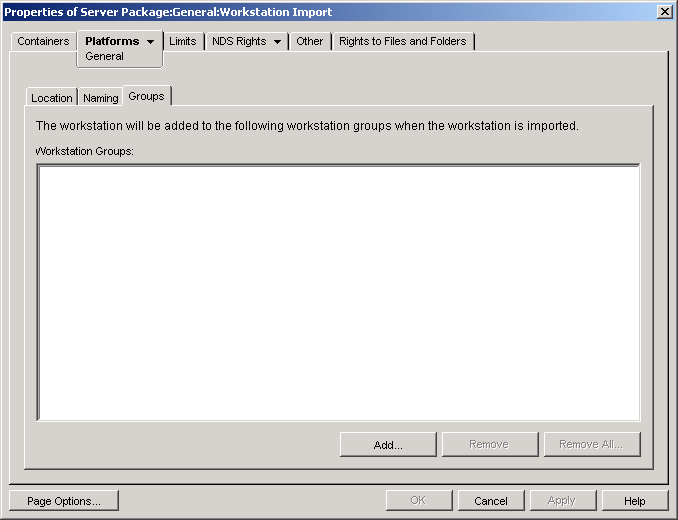
-
Click , then browse for and select the workstation groups you want this Workstation object to belong to when it is imported.
-
Click to save the policy.
-
Repeat Step 1 through Step 13 for each platform where you want to set a Workstation Import policy.
-
When you have finished configuring all of the policies for this package, continue with the steps under Section 13.7, Associating the Server Package to associate the policy package.